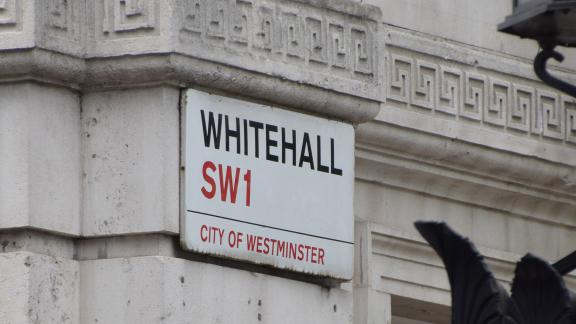Without clarity, courage and honesty we are lost

As the health and care sector braces for a challenging winter, three key steps could support systems to manage risk and minimise harm, writes Matthew Taylor.
I recall a minister in a cash-strapped department offering a vivid description of his plight: “I feel,” he said, “like a six-foot man in a freezing cold room with a five-foot blanket – which parts of my body do I leave exposed?”
NHS leaders will recognise the feeling. The capacity gap in the NHS and care system means the next two to three years, at least, will likely veer between extreme difficulty and full-on crisis.
Given that, it was rather concerning to hear the Prime Minister say this morning (2 October) that the issue for the NHS is not about inputs but specifying outputs. Both the government and the opposition have been guilty recently of willing the ends but not the means, something that suggests a failure to grasp the reality facing leaders on the ground.
Risk to patient safety
More than in 9 in 10 NHS leaders say that risk to patient safety is going to increase as we approach winter
It won’t come as a surprise but more than in 9 in 10 of almost 200 NHS leaders that responded to our latest survey said that risk to patient safety is going to increase as we approach winter. Almost all of them identified the biggest risks being demand for urgent and emergency care and ambulance waits. And most expect to have to make difficult decisions and compromises around safe staffing ratios and delayed transfers of care.
The root causes of the capacity gap are well understood. The NHS has over 130,000 vacancies, we lag well behind other OECD countries on capital spending and the social care sector is starved of investment. We know about the impact of population ageing and the COVID-19 backlog, but we don’t fully understand what is driving ever greater demand and acuity. There is no government strategy to address these underlying drivers.
This is one reason why the well-intentioned NHS England guidance note on winter planning got a mixed reaction from system leaders back in August. It wasn’t so much that there was anything wrong with the contents, more the implicit message that as long as systems did what they were told the situation would be manageable. For many leaders this defies reality.
Far from adequate
The Secretary of State for Health and Social Care’s Plan for Patients offered some help, including a £500 million fund to support discharge from hospital into the community. With around one in seven beds taken up by patients who are medically fit to leave, this will help boost capacity in the community.
It is one of the main areas identified by NHS leaders responding to our survey as it will help improve patient flow and reduce ‘exit block’. But at this stage we don’t know where the money will be directed and, crucially, where the money will come from. Winter is almost upon us, so clarity is urgent.
Any help is gratefully received, and leaders have gone out of their way to engage positively with the new Department of Health and Social Care ministerial team. But the announced measures are far from adequate to the task.
Daily dilemmas
I have spoken to several acute trust leaders about the day-to-day dilemmas felt across their systems. Many have thought hard about risk and concluded – as has NHS England – that patient safety was most comprised by long ambulance waits. Their view was that so long as a patient was in the system, even if in a stacked ambulance or on a trolley, they were safer than lying at home without medical attention.
This view is soundly based given estimates suggesting patients suffering potential harm as a result of 60-minute delays have reached nearly 40,000 per month. Therefore, many trusts have decided to move patients who needed to be admitted out of the overcrowded emergency department and – if necessary – place them in corridors outside wards.
Clear thinking and an ethical commitment to minimising patient harm means leaders are willingly taking greater risk into their organisations
The growth of ‘corridor care’ is a legitimate response to the capacity gap, but it creates challenges for hospitals. For staff, most of whom have been working in incredibly tough circumstances for several years, it increases workload and risk. Also, as leaders acknowledge, it is unlikely that patients in corridors would go down well with inspectors (although the Care Quality Commission tell me the issue is less the existence of corridor care and more the way it is implemented).
However, a combination of clear thinking and an ethical commitment to minimising patient harm means leaders are willingly taking greater risk into their organisations.
The rhetoric of risk
The broader point concerns how the system thinks and talks about risk. Documents produced by NHS England, such as the recent National Guidance on Quality Risk Response and Escalation in Integrated Care Systems, are authoritative and useful. However, they tend to treat risk as something that can be mitigated by using the right managerial and clinical processes.
We cannot go on as we are... something has to change
During the worst of COVID-19, a very different approach was adopted. On the one hand, systems and providers were told to do whatever was necessary to address the public health risks posed by the pandemic. On the other, our partners and the public were asked and expected to change their own expectations and behaviours to support the health service.
Given the pressures of today and trepidation about winter, many leaders I speak to think we need to return to the operational flexibility and public openness and engagement of COVID-19, seeing it not as a crisis response but simply the way we need to operate until further notice.
Of course, we must strike the right balance and cannot sleepwalk into the kind of care failings we have seen before. But neither can we go on as we are, refusing to acknowledge the reality we face. Something has to change.
Being candid with the public
All of this requires a more honest conversation, at all levels. For some months, starting at NHS ConfedExpo, the NHS Confederation has been calling for a ‘reality reset’. As we saw from the Conservative leadership contest, our politicians seem often detached both from what is going on in the health and care system and the demand and capacity pressures that lie behind our current plight.
It’s why our members told us in our survey that the government and national bodies need to be far more open and frank with the public when it comes to the scale of the challenge facing the NHS this winter.
The government and NHS national leaders need to be even clearer in these three ways:
1. The need for a robust and honest assessment of harm
All systems look at risk and are accountable for doing so. Indeed, a system leader I spoke to last week had just come from an intensive session focused on understanding and sharing winter risk. But perhaps we need to be willing to go further and have a bigger conversation.
Integrated care systems (and this includes our local authority and voluntary, community and social enterprise sector partners) need to be supported to undertake a robust and honest assessment not just of risk but of harm in their systems. This means confronting and communicating some difficult truths.
Given the focus on hospital, we tend to underestimate risks lying in other parts of the system
Ambulance response and handover times are an obvious example, but one system leader I spoke to argued that the backlog of regular health checks was equally harmful but less discussed. Another – looking through a wider lens – argued that the collapse of domiciliary care is the greatest cause of suffering. Also, given the focus on hospital, we tend to underestimate risks lying in other parts of the system, like mental health and community services.
It isn’t easy to face up to a difficult reality, particularly when there are no easy solutions. One acute leader told me that he had identified a significantly higher mortality rate among his patients, but that his system didn’t seem keen to engage, perhaps because they thought this would presage a request for more help.
Honest conversations about risk and harm can feel difficult and even dangerous. But, surely, they must happen.
2. The role of systems in minimising harm
Second, NHS England needs to be clear that it lies with systems to determine how best to minimise harm. We have consistently argued that integrated care boards (ICBs) should seek to be empowering and enabling, not controlling and interfering, bodies.
However, allocating risks across a system to minimise harm is something systems have to do. My sense is that if a robust case is made at system or place level, the vast majority of partners will accept that they have to do what is necessary.
The new Secretary of State must avoid the mistake of her predecessor in thinking that problems with urgent and emergency care lie solely with acute leaders
But minimising public harms in circumstances like the ones we are now facing will often require system partners and providers – as many do – to be willing to do things very differently and sometimes to lay aside the immediate interests of the organisation they lead. This is never easy, but it is even harder when leaders feel a deep sense of responsibility about the burdens that have had to be put onto the shoulders of their colleagues over the last 30 months.
The new Secretary of State must avoid the mistake made by her predecessor in thinking that problems with urgent and emergency care lie solely with acute leaders. The danger is that we opt for acute-focused, short-term measures that fail to address the need for more fundamental shifts in services and what we offer the public.
With integrated care systems now in place, we need a system response which incorporates good and proven practice but also recognises that the nature of risk and the steps that can be taken to manage it vary from system to system, reflecting factors such as demography, geography and capacity. And even in this time of pressure we need to practice ‘split-screen thinking’; managing risk today in ways which align with our longer-term vision for care.
3. The role of the centre in providing a helping hand
Third, the message systems and providers need to hear from NHS England is that regions and the centre are here to help. If minimising harms means saying and doing difficult, risky, unpopular, unconventional things then leaders need to know that, as long as their actions are based on a clear and robust case that have patient safety and avoiding harm at their heart, the centre has their back.
We need to close the confidence gap immediately with more visible support from regulators
Nationally, for example, CQC recognises the pressures the system is under, but this is not always reflected in the attitudes of inspection teams on the ground. Similarly, COVID-19 saw a number of unofficial service reconfigurations to help with infection control and the deployment of resources.
But the majority of the NHS leaders responding to our survey do not have confidence that regulators would understand and support a decision to take on additional risk within their organisation if it was seen to avoid patient harm across the wider system. We need to close this confidence gap immediately with more visible support from regulators.
NHS leaders responding to our survey were clear that another way in which we can close this confidence gap is by heads of professions nationally, such as chief nursing officers, and regulators, including the Nursing and Midwifery Council and the General Medical Council, clearly communicating to clinicians that there is an appreciation of the challenging context this winter and the changes people may be being asked to make in their practice.
A tough next chapter
Unless we take these steps, we are adding to the severity of the challenge. Right now, I am having conversations just about every day with leaders who are not only finding it difficult to cope but feel deeply responsible for the increasingly impossible demands they are placing on staff. Not only does it continue to feel like mid-winter, as it has all summer, but many operational areas – particularly social care – are continuing to deteriorate.
The Secretary of State and her Prime Minister have at last burst the Johnson myth that ‘social care has been sorted’, and the adult social care discharge fund is a step in the right direction.
But as one NHS leader who responded to our survey told us: “There is very little that can be put in place now that will have a significant impact this winter – it is too late. But the thing to fix is social care capacity to allow patients to flow through the hospital system.”
The Secretary of State will be speaking at the Conservative party conference on Tuesday. She has the opportunity to build on her Plan for Patients by outlining more detail on her NHS winter support package.
But whatever she does at this stage, nothing is going to make the next chapter for health and care anything but incredibly tough. However, the one thing that she and our national leaders can offer is clarity, courage and honesty. For, without this, we are lost.
Matthew Taylor is chief executive of the NHS Confederation. Follow Matthew on Twitter @FRSAMatthew



